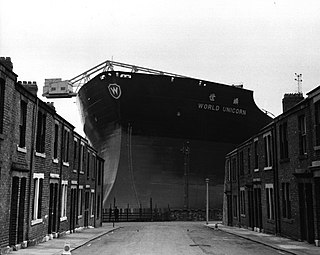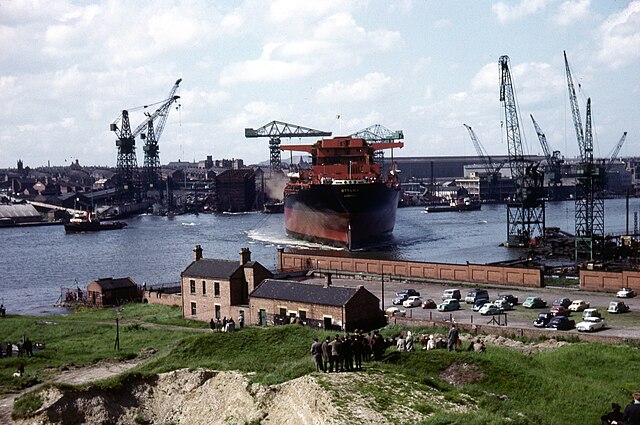Loading AI tools
Shipbuilding company based in England From Wikipedia, the free encyclopedia
Swan Hunter, formerly known as Swan, Hunter & Wigham Richardson, is a shipbuilding design, engineering, and management company,[1] based in Wallsend, Tyne and Wear, England.
| Company type | Private |
|---|---|
| Industry | Shipbuilding Naval architecture Offshore installation services |
| Founded | 1880 |
| Headquarters | Wallsend, Tyne and Wear, England |
Key people | Gerard Kroese, (Director) |
Number of employees | 25 including contractors (2017) |
| Website | swanhunter |


At its apex, the company represented the combined forces of three powerful shipbuilding families: Swan, Hunter and Wigham Richardson.
The company was responsible for some of the greatest ships of the early 20th century, most famously RMS Mauretania which held the Blue Riband for the fastest crossing of the Atlantic, and RMS Carpathia which rescued survivors from RMS Titanic.
In 2006 Swan Hunter ceased vessel construction on Tyneside, but continues to provide design engineering services.
Swan & Hunter was founded by George Burton Hunter, who formed a partnership with the widow of Charles Sheridan Swan (the owner of a Wallsend Shipbuilding business established in 1852 by Charles Mitchell)[2] under the name in 1880.[3]
In 1903, C.S. Swan & Hunter merged with Wigham Richardson (founded by John Wigham Richardson as Neptune Works in 1860), specifically to bid for the important contract to build RMS Mauretania on behalf of Cunard.[4] Their bid was successful, and the new company, Swan Hunter and Wigham Richardson Ltd, went on to build what was to become, in its day, the most famous oceangoing liner in the world. Also in 1903, the Company took a controlling interest in the Wallsend Slipway & Engineering Company, which was an early licensed manufacturer of Parsons steam turbine engines, which enabled Mauretania to achieve her great speed.[5] Mauretania was launched from Wallsend on 20 September 1906 by the Duchess of Roxburghe.[6] The firm expanded rapidly in the early part of the twentieth century, acquiring the Glasgow-based Barclay Curle in 1912.[5]
In 1966, Swan Hunter & Wigham Richardson merged with Smiths Dock Company to form Associated Shipbuilders, which later became Swan Hunter Group.[7] Following the publication of the Geddes Report recommending rationalisation in British shipbuilding, the Company went on to acquire Clelands Shipbuilding Company[8] and John Readhead & Sons in 1967.[9] Meanwhile, Swan Hunter inherited both the Naval Yard at High Walker on the River Tyne of Vickers-Armstrongs[8] and the Hebburn Yard of Hawthorn Leslie in 1968.[9] In 1973 further expansion came with the purchase of Palmers Dock at Hebburn from Vickers-Armstrongs.[10]
Then in 1977, Swan Hunter Group was nationalised as part of British Shipbuilders.[7] The former flagship of the Royal Navy, HMS Ark Royal was built at Swan Hunter during this period, entering service in 1985.[11]
The Company was privatised again in 1987 but decided to close its Neptune Yard in 1988.[12] It was then forced to call in the receivers when the UK government awarded the contract for HMS Ocean to Kvaerner Govan in 1993.[13] The receiver took steps to break up the business.[14] However, the main shipyard in Wallsend was bought out from receivership by Jaap Kroese, a Dutch millionaire.[7] The yard subsequently undertook several ad-hoc ship repair and conversion projects for private-sector customers.[15]

In 2000, Swan Hunter was awarded the contract to design and build two (Auxiliary) Landing Ship Dock ships for the Royal Fleet Auxiliary with two other ships being built by BAE Systems Naval Ships: the cost of the two Swan Hunter ships was to be £210 million including £62 million for lead yard services, with an inservice date of 2004.[16] By July 2006, the costs had risen to £309 million and only one ship had been delivered. As a result of this, the second ship RFA Lyme Bay was transferred to BAE Systems Govan in Glasgow for completion.[17]
In 2001, Swan Hunter acquired Kværner's Port Clarence offshore yard at Teesside[18] but then in 2006 sold it to Wilton Engineering Group.[19]
In November 2006, after the failure to complete Lyme Bay within budget and resulting exclusion from future Royal Navy shipbuilding projects, Jaap Kroese announced that the business was effectively finished and placed the Wallsend Yard's iconic cranes up for sale. He also said that he was actively looking for a buyer for the land.[20] During this time, Lyme Bay's earlier sister ship, Largs Bay, was noted as the last ship to be built and fully completed by Swan Hunter. In April 2007, Swan Hunter's cranes, along with its floating dock and other equipment, were sold to Bharati Shipyards, India's second-largest private-sector shipbuilder. The entire plant machinery and equipment from Swan Hunter was dismantled and transported to India over six months to be rebuilt at Bharati Shipyards.[21]
Swan's performed the conceptual design of Pioneering Spirit, provisionally named Pieter Schelte, the world's largest platform installation/decommissioning and pipelay vessel. The basic design of the lifting systems was completed by the end of 2008, and detailed design of the hulls by May 2010.[22]
In 2008, the company said it was concentrating on ship design with just under 200 people employed.[1][23]
In 2016, Jaap Kroese died but the company said it would continue with its business of ship design. At the time, the company had 40 employees and contractors.[24]
Also in 2016, Swan Hunter was relaunched into the subsea industry by Gerard Kroese, the eldest son of former owner Jaap Kroese. Swan Hunter started to offer specialist equipment, design, engineering & project management services to the offshore renewables and subsea oil & gas energy markets.[25] On 12 October 2016, the company announced the issue of a letter of intent for the design and build of a basket carousel loading tower.[26] The company announced further equipment pool growth through a 15Te tensioner and 450Te reel drive system.[27] Swan Hunter announced loading tower readiness on 5 May 2017[28] with completion of mobilisation onto EMAS Chiyoda Subsea's multi-lay vessel 'Lewek Constellation' shortly thereafter.[29]
The Company owned three main yards:
All three were on the north side of River Tyne. The company also owned the Wallsend Slipway & Engineering Company, the yard that built the engines for the Mauretania, from 1903 until the 1980s. At various times Swan Hunter also owned Palmers Hebburn Yard, Hawthorn Leslie Hebburn Yard and Readheads at South Shields which were all on the south side of the River Tyne.
Naval vessels
Commercial vessels
Cable ships
Bulk Carrier
Research Vessels
Tankers
On 1 May 2006, British pop-duo Pet Shop Boys performed their soundtrack to the 1925 Soviet silent-film Battleship Potemkin alongside the Royal Northern Sinfonia at the shipyard.[43]
Seamless Wikipedia browsing. On steroids.
Every time you click a link to Wikipedia, Wiktionary or Wikiquote in your browser's search results, it will show the modern Wikiwand interface.
Wikiwand extension is a five stars, simple, with minimum permission required to keep your browsing private, safe and transparent.